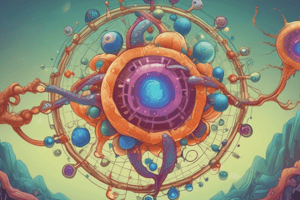Podcast
Questions and Answers
What is the primary function of chloroplasts in plant cells?
What is the primary function of chloroplasts in plant cells?
- Cell division
- Storage of nutrients
- Photosynthesis (correct)
- Water absorption
Which of the following tissues in plants is responsible for transport?
Which of the following tissues in plants is responsible for transport?
- Ground tissue
- Meristematic tissue
- Vascular tissue (correct)
- Dermal tissue
What mechanism does not describe plant reproduction?
What mechanism does not describe plant reproduction?
- Asexual reproduction
- Seed formation
- Binary fission (correct)
- Sexual reproduction
Which characteristic is true for animals in relation to their energy source?
Which characteristic is true for animals in relation to their energy source?
Animal behavior is influenced by which of the following factors?
Animal behavior is influenced by which of the following factors?
What is the primary function of ribosomes in a cell?
What is the primary function of ribosomes in a cell?
What distinguishes prokaryotic cells from eukaryotic cells?
What distinguishes prokaryotic cells from eukaryotic cells?
Which of these best describes natural selection?
Which of these best describes natural selection?
Which of the following is considered a biotic factor in an ecosystem?
Which of the following is considered a biotic factor in an ecosystem?
What role do mutations play in genetics?
What role do mutations play in genetics?
What is a key characteristic of adaptations in evolution?
What is a key characteristic of adaptations in evolution?
Which part of the cell is responsible for regulating what enters and exits the cell?
Which part of the cell is responsible for regulating what enters and exits the cell?
What does biodiversity encompass?
What does biodiversity encompass?
Flashcards
Cell Function
Cell Function
Cells perform specific tasks due to their shapes and components.
Cell Membrane
Cell Membrane
A barrier controlling what enters and exits the cell.
Eukaryotic Cell
Eukaryotic Cell
A cell with a nucleus and membrane-bound organelles.
Gene
Gene
Signup and view all the flashcards
Natural Selection
Natural Selection
Signup and view all the flashcards
Ecosystem
Ecosystem
Signup and view all the flashcards
Biodiversity
Biodiversity
Signup and view all the flashcards
Prokaryotic Cell
Prokaryotic Cell
Signup and view all the flashcards
Photosynthesis
Photosynthesis
Signup and view all the flashcards
Chloroplast
Chloroplast
Signup and view all the flashcards
Animal
Animal
Signup and view all the flashcards
Plant tissues
Plant tissues
Signup and view all the flashcards
Animal reproduction
Animal reproduction
Signup and view all the flashcards
Study Notes
Cell Biology
- Cells are the fundamental units of life, exhibiting a wide range of shapes and structures adapted to specific functions.
- Key components include the cell membrane, cytoplasm, and organelles.
- The cell membrane is a selectively permeable barrier, regulating the passage of materials into and out of the cell.
- Cytoplasm is the jelly-like substance within the cell, containing enzymes and other molecules crucial for metabolism.
- Organelles like mitochondria (powerhouses of the cell), ribosomes (protein synthesis), and the nucleus (containing genetic material) perform specific tasks.
- Prokaryotic cells (bacteria and archaea) lack a nucleus and membrane-bound organelles.
- Eukaryotic cells (plants, animals, fungi, and protists) possess a nucleus and membrane-bound organelles.
Genetics
- Genes are segments of DNA that carry the hereditary information.
- DNA, composed of nucleotides, stores genetic instructions.
- RNA plays a crucial role in protein synthesis, acting as a messenger between DNA and ribosomes.
- Chromosomes are thread-like structures of DNA containing genes.
- Genes code for specific proteins, which determine traits and characteristics.
- Mutations are changes in DNA sequence, impacting traits.
- Mendelian genetics describes hereditary patterns within families.
Evolution
- Evolution is the change in heritable characteristics of biological populations over successive generations.
- Natural selection is a key mechanism of evolution, where organisms with advantageous traits are more likely to survive and reproduce.
- Adaptations are traits that enhance survival and reproduction in a given environment.
- Speciation is the formation of new species over time.
- Common ancestry connects all life forms through evolutionary lineages.
Ecology
- Ecology examines the interactions between organisms and their environment.
- Ecosystems include all living organisms (biotic factors) and non-living components (abiotic factors).
- Food webs depict the energy flow among organisms within an ecosystem.
- Biodiversity refers to the variety of life on Earth, encompassing genetic, species, and ecosystem diversity.
- Biomes are large-scale ecosystems characterized by specific climates and communities of organisms.
- Human activities are major drivers of environmental change.
Plant Biology
- Plants are multicellular photosynthetic organisms that play crucial roles in ecosystems.
- Photosynthesis is the process by which plants convert light energy into chemical energy.
- Plant cells contain chloroplasts, specialized organelles for photosynthesis.
- Plant tissues include dermal, vascular, and ground tissues, with distinct functions.
- Plant reproduction involves both sexual and asexual mechanisms.
- Plants exhibit diverse adaptations for survival in various environments.
Animal Biology
- Animals are multicellular organisms that lack chlorophyll and rely on external food sources.
- Animal tissues form organs and systems, each performing specific functions.
- Animal development proceeds through stages, from fertilized egg to adult.
- Animal reproduction varies among species.
- Animal behavior is shaped by genetic and environmental factors.
- Diversity among animal groups is vast and well-fitted to different habitats.
Studying That Suits You
Use AI to generate personalized quizzes and flashcards to suit your learning preferences.




